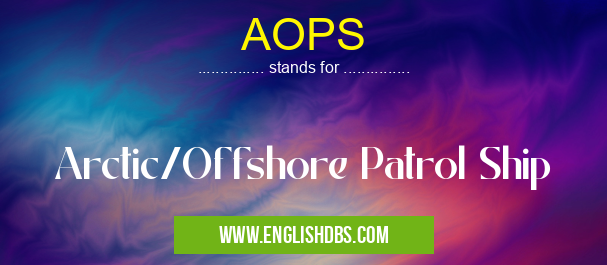What does AOPS mean in SHIPPING & SAILING
Arctic/Offshore Patrol Ships (AOPS) are vessels designed with the capability to support a wide range of government operations in challenging and often harsh Arctic and offshore environments. AOPS can carry out surveillance, control, search and rescue, and protection missions in the frigid waters of Canada’s North. Constructed with a strong hull capable for icebreaking, these ships are the eyes and ears of Canadian security in remote coastal regions.

AOPS meaning in Shipping & Sailing in Miscellaneous
AOPS mostly used in an acronym Shipping & Sailing in Category Miscellaneous that means Arctic/Offshore Patrol Ship
Shorthand: AOPS,
Full Form: Arctic/Offshore Patrol Ship
For more information of "Arctic/Offshore Patrol Ship", see the section below.
Role & Benefits
The roles fulfilled by AOPS determine their benefits to Canadian security operations. Subsequently, these ships have a wide spectrum of tasks that they can undertake such as illuminations support operations (ISR), defensive-fighting operations (DCO), disaster relief (DR) or providing assistance on other humanitarian missions. Furthermore, since the Arctic Coastline is largely inaccessible during wintertime due to its nearly impenetrable icy environment; this makes it possible for AOPS vessels serve as “lifelines” during those times. For example; when there is need of resupplying communities located nearby the coastlines with necessary supplies such as food or medication from outside the region; they become invaluable assets towards achieving such goals.
Essential Questions and Answers on Arctic/Offshore Patrol Ship in "MISCELLANEOUS»SHIPS"
What is an AOPS?
An Arctic/Offshore Patrol Ship (AOPS) is a type of naval vessel designed to protect Canada’s sovereignty in the Arctic and its offshore maritime zones. These ships are versatile, with the capability to patrol and respond to a wide range of threats.
What capabilities does an AOPS have?
An AOPS has the capability to monitor, provide presence, perform surveillance operations, carry out research and complete environmental protection activities in Canada’s Northern regions and offshore waters. They are also able to conduct search and rescue missions, defend against potential threats, deliver humanitarian assistance, enforce laws and protocols at sea, and support international efforts on behalf of Canada.
Where will the AOPS be operating?
The AOPS will be operating in both the Arctic Ocean and Canada's offshore waters along all three coasts - Pacific Coast, Atlantic Coast, and on the East Coast for Newfoundland/Labrador.
How many AOPS ships have been commissioned so far?
Seven Canadian Surface Combatants (CSC) have been commissioned so far - Harry DeWolf (2019), Margaret Brooke (2020), Max Bernays (2020), Fredericton (2022), Kingston (2023), Glace Bay (2024), Nanisivik (2025).
Does the AOPS replace other vessels in Canada’s Navy?
The inclusion of an Arctic/Offshore Patrol Ship type as part of the CSC program is meant to replace 12 existing Iroquois-class destroyers which have served their purpose as part of Canadian naval forces since 1972.
What makes AOPS vessels unique?
To be able to effectively patrol our northernmost waters efficiently, each vessel is fitted with advanced communications technology that allows them to communicate with personnel in remote areas as well as specific features like double hulls for greater icebreaking capabilities. All ships also feature low observability technology that reduces their radar signature making them more clandestine while at sea.
What type of weapons are equipped on an AOPS vessel?
Each ship carries an assortment of light-weight weaponry such as small arms fire from remotely operated weapon systems such as machine guns or cannons, surface missiles for precision strikes against airborne threats like fixed wing aircraft or helicopters, countermeasures devices for thwarting enemy attacks think rocket propelled grenades or anti-ship missiles, and underwater mines for defense against hostile submarines or surface ships at close range.
Is there a crew complement required on board an AOP vessel?
Yes, depending on mission requirements each vessel can carry a complement of up to 95 people including officers and sailors who will operate it during its deployment. Auxiliary personnel may also accompany each mission like scientists doing research work or members from allied forces working together with Canadian personnel during certain situations.
How long can an AOP stay at sea without requiring refueling or resupply?
Each vessel has been designed with a maximum range of 10 000 nautical miles allowing them to remain operational in almost any area worldwide before needing refueling or resupply. This amount however can vary depending on environmental conditions encountered during their mission such as extreme ice thickness prohibiting travel speed calculations which could force them into port sooner than planned depending on how long they need to remain underway sustaining maximum performance levels during challenging circumstances..
Final Words:
In conclusion, many nations use offshore patrol ships for border defense applications because they offer additional full-spectrum capabilities than those provided by aircrafts or helicopters alone. These uniquely designed vessels have become increasingly important for helping secure sovereign borders amid growing threats from foreign agents attempting illegal activities within exclusive economic zones around coastal regions of various countries; especially in regards to Canada's strategies against smugglers and illegal immigrants coming into our territories from across the sea border.
